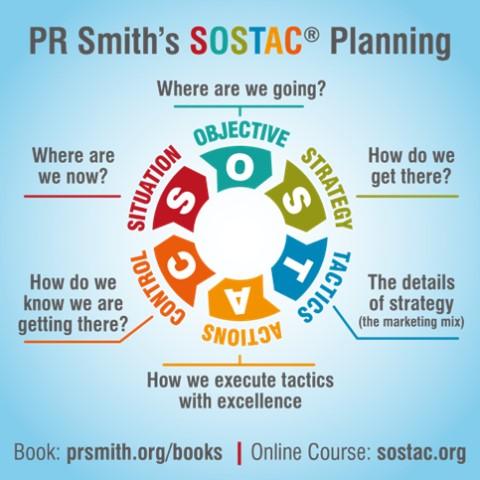Strategy: How to Write the Perfect Plan using SOSTAC® Planning methodology
In Part 1 we looked at introducing SOSTAC® Planning methodology.
In Part 2 we looked at Situation Analysis (where are you now?) which included customer analysis, competitor analysis, company analysis and external trends analysis. The Situation Analysis is the biggest part of the plan. The deeper/better the analysis, the easier the subsequent decisions become. In fact, the strategic solutions often jump out from a deep situation analysis!
Now, in Part 3 we will explore SOSTAC® Objectives and Strategy. We’ll focus on Strategy as this is crucial. But, first, a few brief words on Objective/s.
OBJECTIVE/S (where are we going?)
 Your Mission and Vision are over-riding objectives which can be repeated throughout a plan. Missions are selfless statements that summarise how your products and services make the world a better place (should simultaneously motivate staff plus offer guidance for future growth and some protection in times of crisis). Vision statements are more selfish – about being the best, the biggest, the Top 10 etc.
Your Mission and Vision are over-riding objectives which can be repeated throughout a plan. Missions are selfless statements that summarise how your products and services make the world a better place (should simultaneously motivate staff plus offer guidance for future growth and some protection in times of crisis). Vision statements are more selfish – about being the best, the biggest, the Top 10 etc.
And then we have the KPIs (Key Performance Indicators) which, in marketing terms, can be divided into Marketing (activity-based) and MarComms (mind-based). Activity means clicks, visits, engagements, sales, market share etc. Mind-based means awareness levels, preference levels, sentiment and more. All of these must be SMART objectives (numbers, timescales and more).
Strategy is the shortest part of the plan. A paragraph, a half page or perhaps a tiny bit more but no more than a page as this is too much detail i.e. you are spilling into tactics. Strategy should be short, crisp and clear. George Bradt, a Forbes strategy author, told me that GE wouldn’t exist in 10 or 20 years because none of their strategies fit onto a napkin. Regardless, your strategy should explain how you are going to achieve your objectives. It can also identify a barrier and explain how you will get around it or through it. Strategy should be so clear that you know what you need to do. A good clear strategy helps you know what you won’t be doing.
Types of Strategy
 Let’s consider two main types:
Let’s consider two main types:
1. Product Portfolio Strategy (various matrices which identify business units for growth and others for deletion i.e. McKinsey/GE, BCG matrices etc.)
2. Single Product Strategy (in the case of a single business unit i.e. a product or a product line) – this is what we focus on here in this post.
Single Product Strategy - Key Components
I met a very highly paid global consultant, whom I knew had taken three (yes, three) Post Graduate courses in Digital Marketing Strategy since his PhD. I couldn’t wait to meet him to ask him for any examples of a strategy. I collect them. He promised me he’d send me a few. I chased him and eventually got a list of about 12 articles and videos. I sifted through them all and not one strategy was there.
Strategies are rare. I often find strategies are just a retrospective collection of tactics summarised. This is not the best approach. The first big step is to clarify your targeting and positioning (how you want to be positioned/perceived in the minds of your target customers). These are two of the key components amongst several others (in fact, 9 components) that I suggest you consider when developing your strategy. You cannot have a strategy without T(argeting) & P(ositioning).
The main KPI Marketing objective can be included in a strategy statement as it keeps the strategy focussed/anchored around the objective. This is ‘TOP’ (Target Markets, Objectives and Positioning). There are at least 6 other components worth considering when developing your strategies. You don’t have to use all of them, but you should at least consider all of them. Make sure TOP are there. The SOSTAC® Guide to your Perfect Digital Marketing Plan explores all 9 components in some detail and includes 7 actual strategic excerpts.
The Chinese military strategist Sun Tzu wrote The Art of War (over 2,000 years ago). He saw war as a last strategic option. His preferred military strategies win without bloodshed. They win via intelligence. Sun Tzu effectively confirms why the Situation Analysis needs to be comprehensive when it comes to developing great strategies.
Other PR Smith posts, chats, Masterclasses:
[1] 1-hour webinar Business Planning enabled by AI - Worshipful Company of Consultants 5pm Thurs 14 Nov 2024 – recorded for members’ use. Please do not post this video anywhere as the multiple legal restrictions from other 3rd parties.
[2] 30 minutes live chat AI, Innovation & Ethics in Business – on Linkedin every Fri 1pm (UK time)
[3] 1-Day SOSTAC® Masterclass (central London) Thurs 30 Jan 2025
[4] The SOSTAC® Guide to your Perfect Digital Marketing Plan (AI edition) 2025 (Amazon Dec 2024)
[5] SOSTAC® Certified Planner online course CPD Standards office approved www.sostac.org
